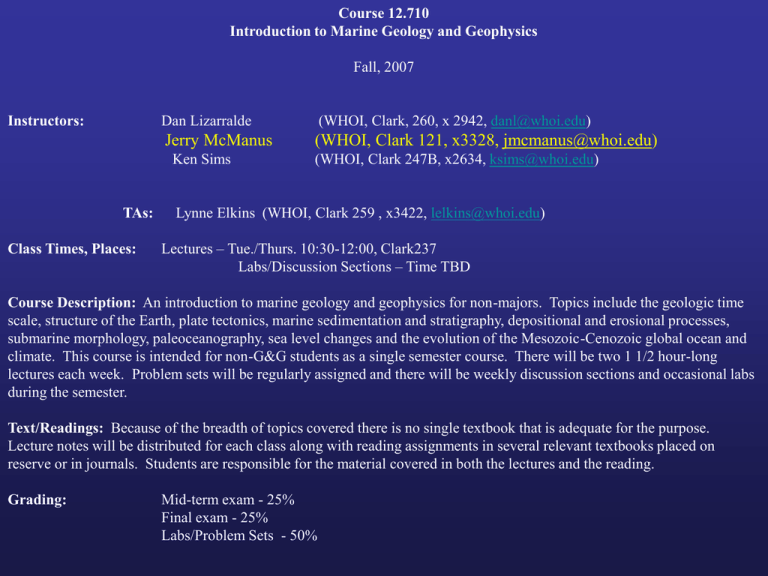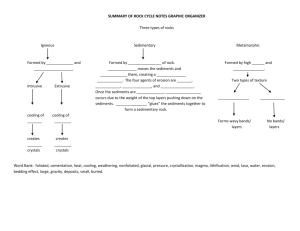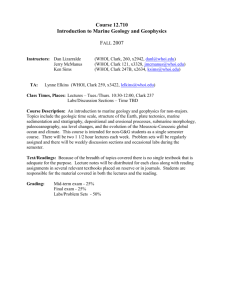Course 12.710 Introduction to Marine Geology and Geophysics
advertisement

Course 12.710 Introduction to Marine Geology and Geophysics Fall, 2007 Instructors: Dan Lizarralde (WHOI, Clark, 260, x 2942, danl@whoi.edu) Jerry McManus (WHOI, Clark 121, x3328, jmcmanus@whoi.edu) Ken Sims TAs: Class Times, Places: (WHOI, Clark 247B, x2634, ksims@whoi.edu) Lynne Elkins (WHOI, Clark 259 , x3422, lelkins@whoi.edu) Lectures – Tue./Thurs. 10:30-12:00, Clark237 Labs/Discussion Sections – Time TBD Course Description: An introduction to marine geology and geophysics for non-majors. Topics include the geologic time scale, structure of the Earth, plate tectonics, marine sedimentation and stratigraphy, depositional and erosional processes, submarine morphology, paleoceanography, sea level changes and the evolution of the Mesozoic-Cenozoic global ocean and climate. This course is intended for non-G&G students as a single semester course. There will be two 1 1/2 hour-long lectures each week. Problem sets will be regularly assigned and there will be weekly discussion sections and occasional labs during the semester. Text/Readings: Because of the breadth of topics covered there is no single textbook that is adequate for the purpose. Lecture notes will be distributed for each class along with reading assignments in several relevant textbooks placed on reserve or in journals. Students are responsible for the material covered in both the lectures and the reading. Grading: Mid-term exam - 25% Final exam - 25% Labs/Problem Sets - 50% Geophysical Methods and Observations 10/25 (Lizarralde) Seismology: Earthquakes and Earth imaging 10/30 (Lizarralde) Potential fields, electro-magnetics, linear inverse theory 11/1 Mid Term Sediments and Sedimentary Processes 11/1 11/6 11/8 11/13 (McManus) (McManus) (McManus) (McManus) Fluvial and coastal sedimentation Marginal sedimentation, sequence stratigraphy Deep-sea sediments: composition, distribution Biological, chemical, and physical abyssal processes Paleo-oceanography and Climate 11/15 (McManus) Dating methods and the sedimentary record 11/20 (McManus) Paleothermometry 11/22 Thanksgiving 11/27 (McManus) Deep water chemistry and atmospheric p(CO2) 11/29 (McManus) Ocean chemistry and continental weathering 12/4 (McManus) Astronomical climate theory 12/6 (McManus) Sedimentary records of abrupt climate change 12/11 Final Exam Deep-Sea Sediments I Sources *1. Continents (dissolved, particulate) 2. Submarine 3. Extraterrestrial II Transport 1. Wind (eolian) 2. Ice 3. Water 4. Gravity III Composition 1. Biogenic (opal, CaCO3, Corg) 2. Lithogenic (clastic) 3. Authigenic (inorganic precipitates) IV Distribution influences: 1. Proximity of source (size) 2. Depth of sea floor (CaCO3) 3. Seawater chemistry (opal, CaCO3) 4. Sedimentation rate (opal, Corg) vs. Accumulation Dust Volcanic eruptions Hydrothermal input Black smoker vents (NOAA) Water (riverine, currents) Amazon discharge (NASA) Wind (eolian) Sahara Dust (NASA) Ice (glaciers, sea ice, icebergs) Classification of Marine Sediment Types Biogenic Sediments: Remains of organisms, mainly carbonates (calcite, aragonite), opal (hydrated silica), and calcium phosphate (teeth, bones, crustacean carpaces), also organic carbon (soft tissues). Arrival at the site of deposition by in situ precipitation (benthic organisms living there) or via settling through the water column (pelagic organisms). Biogenic sediments are widespread on the sea floor, covering one half of the shelves and more than one half of the deep ocean bottom (total ~55%.) They constitute ~30% of total volume of sediment being deposited. Lithogenic Sediments: Detrital products of pre-existing rocks (igneous, metamorphic, sedimentary) and of volcanic ejecta and extraterrestrial material. Transport by rivers, ice, winds. Nomenclature based on grain size (gravel, sand, silt, clay). Additional qualifiers derived from the lithologic components (terrigenous, bioclastic, volcanogenic) and from the structure of the deposits. Fine-grained lithogenic sediments (which become shale upon aging and hardening) are the most abundant by volume of all marine sediments (~70%) primarily due to the great thickness of continental margin sediments. Authigenic (or Hydrogenous) Sediments: Precipitates from seawater or from interstitial water. Also products of alteration during early chemical reactions within freshly deposited sediment. Redissolution common. Nomenclature based on origin (evaporates) and chemical composition. Authigenic sediments, while widespread, are not volumetrically important at present. At times in the past they have been a much more substantial sediment component (e. g., Messinian crisis). Biological activity (plankton) Arabian Sea bloom (NASA) Thickest deposits Terrigenous sediments delivered by rivers Ferro-manganese nodules Slow-growing Require metal input Hjulstrom diagram A) Transport B) Erosion C) Deposition Clay minerals rock -> chlorite (from Fe-Mg minerals) + illite (from feldspars) -> montmorillonite -> kaolinite (in regions of high temperature, good drainage). 2NaAlSi3O8 (albite) + 2CO2 + 11H2O Al2Si2O5(OH)4 (kaolinite) + 2Na+ + 2HCO3- + 4H4SiO4 Clay type varies by weathering regime Chlorite ~ physical Kaolinite ~ chemical > 10 Biogenic sediments a) b) c) d) Coccoliths Foraminifera Diatoms Radiolarians Organic carbon Highly recycled: Preservation due to high productivity and rapid burial. Opal deposits Highly recycled: Preservation due to high productivity and rapid burial. Ocean distributes. CaCO3 deposits Influenced by: Productivity and seawater chemistry, ocean circulation. Carbonate content (after D. Archer)) Intra-basin ocean circulation Biology and Physics influence Chemistry Circulation sweeps nutrients toward the Pacific, and productivity tends to trap them there. From Atlantic to Pacific Ocean: Oxygen declines and silica increases in the deep water. CaCO3 more soluble in the deep ocean: Pressure effect combines with lower [CO3=]. The (“older”) deep Pacific is more corrosive. Pressure effect combines with lower [CO3=]. “Delta carbonate” (D CO3=) is defined as difference from saturation (after Broecker). Sedimentary sequence evolves through time. Sediment cores will reflect that evolution, and can be used for reconstruction.






